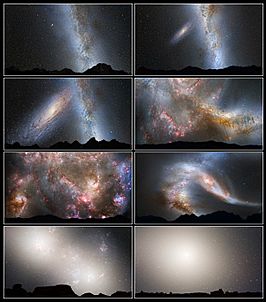Andromeda–Milky Way collision facts for kids
The Andromeda–Milky Way collision is a giant cosmic event that might happen between the two biggest galaxies in our cosmic neighborhood, the Local Group. These two galaxies are our own Milky Way (where we live) and the Andromeda Galaxy. Scientists think this galactic merger could begin in about 4.5 billion years.
Even though it's called a "collision," the stars inside the galaxies are very unlikely to crash into each other. Space is so big and the distances between stars are so huge that they will most likely just pass by one another. Some stars, however, might get flung out into the space between galaxies.
Contents
Are We Sure This Will Happen?

For a long time, scientists were almost certain that this collision was going to happen. They know that the Andromeda Galaxy is speeding towards our Milky Way at about 110 kilometres per second (68.4 mi/s). That's incredibly fast!
In 2012, researchers used the Hubble Space Telescope to carefully track Andromeda's movement. By studying its stars, they concluded that the two galaxies were on a direct path to merge in about five billion years.
However, science is always updating with new information. A study in 2025 looked at the data again, but this time they included the gravitational pull of other nearby galaxies, like the Large Magellanic Cloud and the Triangulum Galaxy. With this new information, they found that the chance of a collision is lower than we thought. There is now about a 50% chance that the two galaxies might not collide within the next 10 billion years.
These kinds of galactic mergers are actually quite common in the universe. Our Milky Way is currently in the process of merging with smaller dwarf galaxies, like the Sagittarius Dwarf Galaxy.
Will Stars Crash Into Each Other?
It is extremely unlikely that any stars will collide during the merger. While the Andromeda Galaxy has about 1 trillion (1,000,000,000,000) stars and the Milky Way has about 300 billion, the space between them is enormous.
Here's a way to imagine it:
- If our Sun were the size of a ping-pong ball, the nearest star to us, Proxima Centauri, would be a tiny pea about 1,100 kilometers (about 680 miles) away.
Even in the crowded centers of galaxies, the average distance between stars is about 160 billion kilometers (100 billion miles). So, as the two galaxies pass through each other, the stars will drift by one another like ships in the night.
What About the Supermassive Black Holes?
Both the Milky Way and Andromeda have a supermassive black hole (SMBH) at their very center. Ours is called Sagittarius A*, and it has a mass equal to about 3.6 million Suns. Andromeda's black hole is even bigger, with the mass of 100 to 200 million Suns.
When the galaxies merge, these two giant black holes will begin to circle each other. Over millions of years, they will get closer and closer. As they spiral inwards, they will send out powerful ripples in the fabric of space and time called gravitational waves.
Eventually, they will crash together and form one even more massive black hole. This huge event could release an incredible amount of energy, possibly creating a very bright object known as a quasar.
What Will Happen to the Solar System?
This cosmic event is happening so far in the future that humans won't be around to see it. Long before the galaxies collide, our Sun will naturally change. In about 1 to 1.5 billion years, the Sun will become so bright and hot that it will make Earth's surface too hot for liquid water to exist, ending all life on our planet.
If the Solar System were still around when the merger happens, it would probably be safe from any direct hits. However, the powerful gravity of the merging galaxies could change our position in space. Scientists predict there's a chance our Solar System could be pushed much farther away from the new galaxy's core, or even get thrown out of the galaxy completely.
A Galaxy Full of New Stars
When two spiral galaxies like ours merge, their huge clouds of gas and dust get squeezed together. This compression can trigger a massive burst of star formation. This is called a starburst galaxy.
The new, combined galaxy could light up with billions of brand-new, bright blue stars. While scientists think most of the gas in our galaxies will be used up by then, the starburst could still be strong enough to be a spectacular sight.
The New Galaxy: Milkomeda
What do you get when you mix the Milky Way and Andromeda? Scientists have a fun nickname for the new galaxy: Milkomeda or Milkdromeda.
According to computer simulations, this new galaxy won't be a beautiful spiral like the ones we see today. Instead, it will likely be a giant elliptical galaxy, which is shaped more like a huge, round ball of stars. Over billions of more years, the other smaller galaxies in our Local Group will also merge with Milkomeda, creating one single, giant galaxy.
See also
 In Spanish: Colisión Vía Láctea-Andrómeda para niños
In Spanish: Colisión Vía Láctea-Andrómeda para niños
- NGC 2207 and IC 2163
- Mayall's Object

